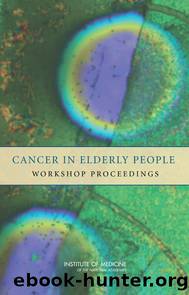CANCER IN ELDERLY PEOPLE: WORKSHOP PROCEEDINGS by Institute of Medicine of the National Academies

Author:Institute of Medicine of the National Academies
Language: eng
Format: epub
Tags: Health and Medicine : Aging. Health and Medicine : Diseases - Cancer
Publisher: NATIONAL ACADEMY PRESS
Published: 2007-04-02T00:00:00+00:00
Figure 2-12 is an example of one algorithm for managing older patients with cancer. Unfortunately, the initial construct separates patients into frail or nonfrail. The frail will get palliation, but there is no definition of this palliation in any detail, and the nonfrail will go through a series of decisions and may or may not get treatment without defining very clearly what we mean by life-prolonging treatment versus palliation.
The models for geriatric cancer care need to be made more sophisticated. I support using a comprehensive geriatric assessment. The assessments that are currently being used include functional status, comorbidity, socioeconomic issues, nutritional status, polypharmacy, and geriatric syndromes. However, they need also to consider a good symptom assessment scale, information about the patientâs shared decision-making process, where patients stand on advance directives, and goals of care. This is an opportunity where palliative care and geriatrics can come together, al though, the National Institute on Aging repeatedly tells me that they focus on aging, and dying is not something they want to talk about.
How do we interface geriatrics and palliation? I think the domains clearly involve access to care, patient-centered care, and some ethical issues that are at the forefront and need a great deal of discussion and leadership: issues of nutrition and hydration, of sedation, where physician-assisted suicide and euthanasia really come to the fore. They are part of the public fabric of our discussions about these issuesâinvolving the role of volunteers, funding, research, and challenges to organizational structures. Clearly, some open, transparent discussions about these are critically important.
Figure 2-13 displays the formalized, integrated model that addresses both curative and palliative care for chronic progressive illness. In the care of the cancer patient we should build into the algorithm in Figure 2-12 that patients, depending on their needs, will receive palliative care. This is different than supportive care, which, in the cancer literature, is about treating symptoms caused by chemotherapy; it is about blood products. There should be explicit data about the use of supportive therapies, but they are not palliative care services. There are clear national guidelines for palliative care and guidelines for who should receive that care. These need to be interfaced more closely with geriatrics.
FIGURE 2-13 Integrated model for chronic progressive illness.
SOURCE: WHO Expert Committee, 1990.
Download
This site does not store any files on its server. We only index and link to content provided by other sites. Please contact the content providers to delete copyright contents if any and email us, we'll remove relevant links or contents immediately.
Application of a Novel Technique for Clinical Evaluation of Nitric Oxide-Induced Free Radical Reactions in ICU Patients by Unknown(694)
Rosenâs Emergency Medicine Concepts and Clinical Practice by Ron Walls; Robert Hockberger; Marianne Gausche-Hill; Timothy B. Erickson; Susan R. Wilcox(572)
Oxidative damage to surfactant protein D in pulmonary diseases by Vitality Starosta1 & Matthias Griese1†(406)
Social Science Perspectives on Global Public Health by Vincent La Placa & Julia Morgan(372)
Constructing Canine Consent; Conceptualising and Adopting a Consent-focused Relationship with Dogs by ERIN JONES(330)
Organic Chemistry: An Acid - Base Approach by MICHAEL SMITH(299)
ADVANCED EMERGENCY CARE AND TRANSPORTATION OF THE SICK AND INJURED by Unknown(271)
Saunders Nursing Drug Handbook 2024 - E-Book by Unknown(262)
Diagnostic and Statistical Manual of Mental Disorders, Fifth Edition, Text Revision (DSM-5-TR(tm)) by Unknown(246)
Davis's Comprehensive Manual of Laboratory and Diagnostic Tests with Nursing Implications by Unknown(245)
Socio-Life Science and the COVID-19 Outbreak : Public Health and Public Policy by Makoto Yano; Fumihiko Matsuda; Anavaj Sakuntabhai; Shigeru Hirota(245)
Human Microanatomy; Cell Tissue and Organ Histology with Celebrity Medical Histories by Stephen A. Stricker(243)
Berne and Levy Physiology E-Book by Unknown(234)
Replacing the Dead by Mie Nakachi;(229)
Handbook of Skin Disease Management by Jiyad Zainab;Flohr Carsten; & Carsten Flohr(228)
Access to Medicines and Vaccines in the South : Coherence of Rules and Policies Applied by the European Union Commission by Stephen Kingah(225)
The Pocket Guide to Sensorimotor Psychotherapy in Context (Norton Series on Interpersonal Neurobiology) by Pat Ogden(218)
Deep Learning and Medical Applications by Unknown(217)
Advances and Technical Standards in Neurosurgery by Unknown(213)
